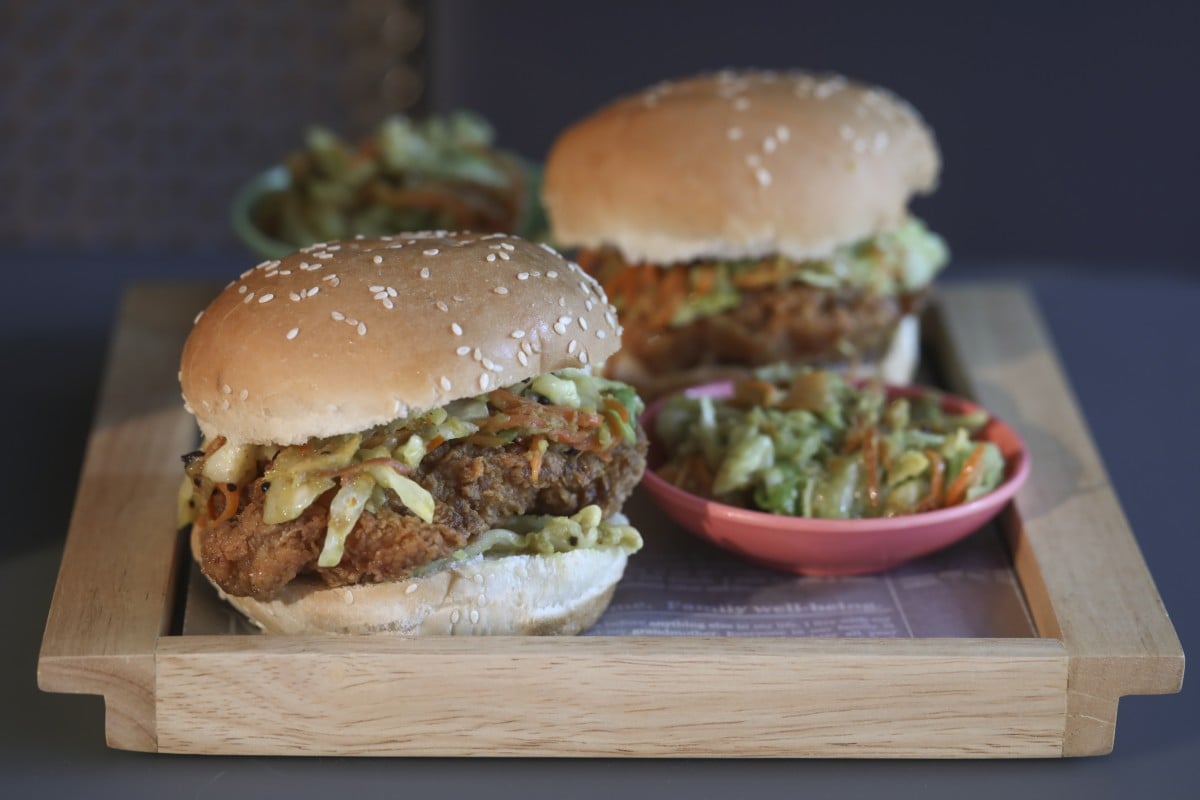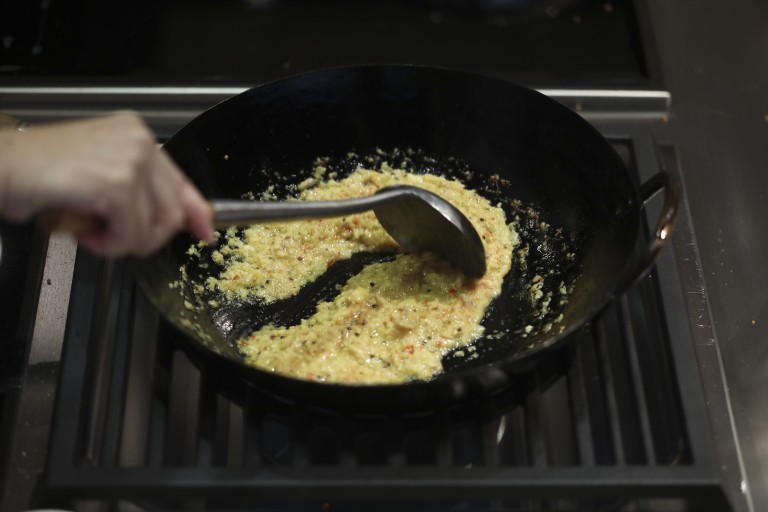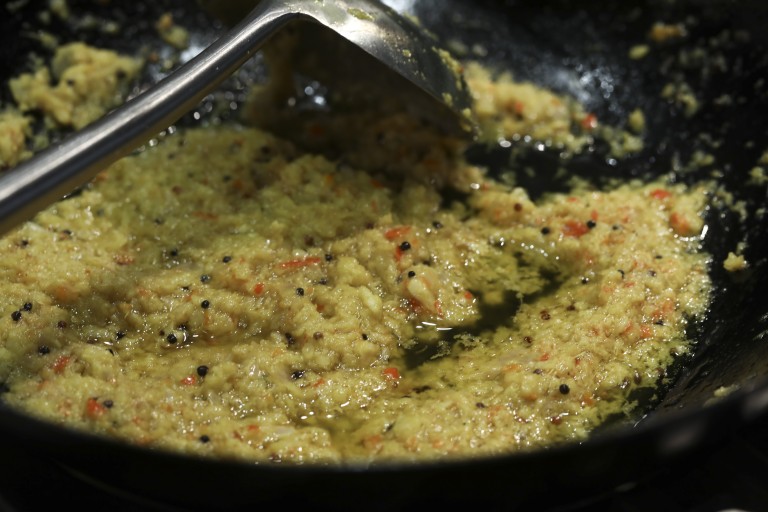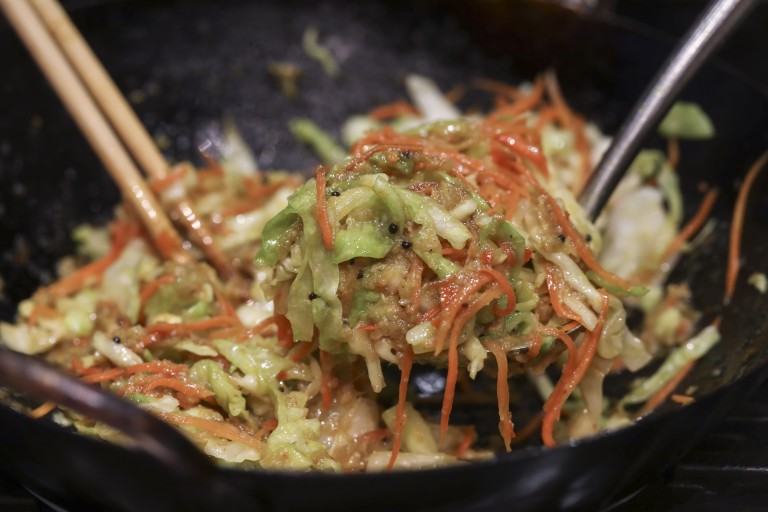
The marinade for these fried chicken sandwiches couldn’t be easier, but the slaw takes a little work. Acar is a Southeast Asian vegetable pickle, and every cook has their own recipe. This one is made with ground aromatics that include chillies, shallots, garlic, galangal and turmeric, which are cooked with dried belacan (fermented shrimp paste), mustard seeds and tamarind pulp, before being mixed with salted cabbage and carrot.
While traditional cooks would use a mortar and pestle to pound the mixture of spices, it’s much easier to grind them in a high-speed blender.
Belacan comes in hard, dry blocks, or in jars, where it is more moist. For this recipe, use the dry version. The sambal belacan can be purchased or homemade.
Candlenuts can be difficult to source – look in shops specialising in Malaysian-Singaporean-Indonesian ingredients, where you’ll also find the belacan, sambal belacan and other ingredients. If you can't find candlenuts, substitute macadamia nuts.
If you can’t find fresh galangal, use the juicy lower part (about 8cm) of a lemongrass stalk. Lightly crush the length of the stalk, then slice it as thinly as possible before grinding with the other aromatics.
Boneless chicken thighs are not always easy to find – shops usually sell boneless legs, which has both the thigh and drumstick. I buy bone-in thighs and remove the bones myself; it takes about 30 seconds for each one.
For the coating for the chicken, you can use whatever starch you like. My preference is for Gogi (or Kogi) powder – Thai brands of tempura powder (buy a plain, unflavoured one). Sweet potato flour, cornflour (cornstarch) or plain (all-purpose) flour also work. Double-frying the chicken makes it more crisp.
In a medium-sized bowl, mix the sambal belacan with the sugar, salt, lime juice and coconut milk.
If using bone-in thighs, remove the bone. Lay the thighs skin-side down on the cutting board and use a sharp paring knife to cut the meat down the length of the bone. When you get to one side, use the tip of the knife to cut around the joint bone to detach the meat. Holding the bone at a 90-degree angle to the cutting board, scrape the meat away from the length of the bone until you reach the other side. Again, cut around the joint bone to detach the meat.

Put the chicken thighs in the bowl with the marinade and mix to coat the meat evenly. Leave at room temperature for two to three hours (or longer in the fridge), mixing occasionally.
Remove and discard the core of the cabbage. Slice the cabbage into 1cm-wide ribbons and put them in a bowl. Shred the carrot and add it to the bowl.
Sprinkle about 50g (¼ cup) of salt over the cabbage and carrot and mix well. Leave at room temperature for about 45 minutes, mixing occasionally, until the vegetables are wilted.
Pour cool water over the vegetables and rinse them well to remove excess salt. Taste a piece of cabbage and carrot – it should not taste salty. If necessary, rinse the vegetables again.
Take handfuls of the cabbage/carrot and squeeze tightly to remove the excess water, then put the pieces in a colander and set aside.
Put the tamarind pulp in a cup and add 240ml (1 cup) of warm water. Press on the tamarind with a spoon to break it up, then set aside to soak for 30 minutes. Strain the mixture through a sieve placed over a bowl, pressing on the pulp to extract as much flavour as possible.
Roughly chop the shallots, garlic, galangal (or lemongrass), candlenuts, chillies and fresh turmeric (if using). Put the ingredients and five grams (1 tsp) of salt in a blender (preferably a high-speed one) and grind to a rough purée. If using a regular blender, you might need to add some of the tamarind liquid to process the ingredients. Scrape the purée into a small bowl.
Heat a wok over a low flame. Use a small spoon to press on the belacan in a small dish to break it up into little pieces, then put it into the wok. Stir constantly until the belacan is lightly toasted.

Pour 100ml (¼ cup and 2 tbsp and 2 tsp) of oil into the wok and heat it over a medium-high flame. When it’s hot, add the mustard seeds and cook for about 10 seconds (they might pop), then add all of the spice paste and about half of the tamarind soaking liquid.

Turn the flame to medium-low and stir constantly for about two minutes. Turn off the flame and spoon a little of the mixture into a small dish, then allow it to cool. Taste the mixture and add more salt and/or tamarind soaking liquid to balance the flavours. Turn the flame back on and continue to cook while stirring constantly, until the oil floats to the surface of the mixture.

Turn off the flame and cool the mixture to lukewarm. Add the cabbage and carrot and mix until the vegetables are evenly coated.
Put some of the coating starch of choice in a shallow dish. Pour oil to a depth of about 2.5cm (1 in) in a skillet and place over a medium-high flame. Heat to 165° C (330° F).
When the oil is hot, thoroughly coat the chicken pieces in the starch, pressing it so it adheres. Shake off the excess, then place the chicken pieces skin-side down in the hot oil. Cook the chicken in batches; do not crowd the pan.
Fry the chicken for about 10 minutes in total, or until done, turning over the pieces twice. Drain the chicken on paper towels.
Reheat the oil to 180° (350° F). Put the chicken pieces back in the skillet and fry for 30 seconds on each side. Drain on paper towels.